
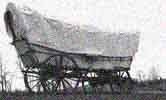
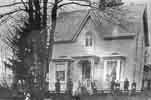
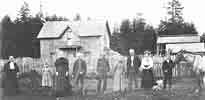
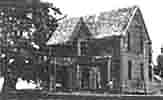
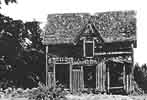
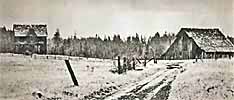
| Home |
| Early Life |
| Maps |
| Oregon Laws |
| The Trail |
| Bush Biography |
| Tumwater Born |
| Thurston County |
| State History |
| Bush
Farm Today |
| FAQs |
| Timeline |
|
Traveler's History of Washington by
Bill Gulick (See footnote 1.) Published
by The Caxton Printers, Ltd., Caldwell, Idaho in
1996 Pages
181 - 188 GEORGE
WASHINGTON BUSH One of the least-known aspects of the Pacific Northwest history is the role played by people of color -- then called Negroes if referred to politely -- in its early development. Long before the Emancipation Proclamation was declared by President Lincoln during the Civil War, an occasional slave was freed by his master as a matter of conscience or as a dying act to express the gratitude of the white owner for the long years of service and loyalty given by the slave and his family. Though the record is hazy, this
seems to have been what happened in the case of
George George Washington Bush, who became one of
the first Americans to settle in the area just
south of Olympia, Washington Territory. In
an article published in Negro
Digest in 1963, the highly respected
historian Ruby E. Hult (see footnote 2)
writes:
Granted their freedom, the parents
named their son, who was half-white and an only
child, after the father of the country, raised
him in the Quaker faith, and gave him a good
education. Enlisting in the army
during the War of 1812, he fought under General
Andrew Jackson during the Battle of New Orleans
and acquitted himself well. Comparing the presumed
birth date 1779 with the statement made later in
the same article that he remained a a bachelor
until he was past forty and married in 1831, I
suspect that he actually was born at least
twenty years later, probably in the 1790s during
President Washington's second term. At any
rate, at any rate he served as an
American soldier during the War of 1812, than
afterward took the course of adventure that many
other young me pursued at that time by going to
work as a trapper for first an American and then
a British fur company. Whatever prejudices the leaders of
these companies may have had, race was not one
of them; they would employ anyone who could
bring in the furs. Whether American or
British, men like John Jacob Astor of the
Pacific Fur Company and Sir George Simpson of
the Hudson's Bay Company were glad to hire any
able-bodied person who would risk his life for
very little money to harvest the furs craved by
well-to-do people in America, Europe, and
Asia. Working as a "free trapper" for
several years during the 1820s, George Bush
became well acquainted with the mountains,
streams, and meadows of the Northwest, traveling
over most of the country from northern
California to British Columbia, learning to know
the region as only a Canadian voyageur
or an American mountain man could know it. STRIFE ON
THE BORDER At some time
during the 1830s, he decided to settle down in
Boone County , Missouri, investing some of the
money he had inherited in a farm, where he
became a stock-raiser and a nurseryman. A
bachelor until past forty, in 1831 he married a
twenty-year-old German-American girl named
Isabella James. To this union, fives sons
were born in quick succession. Though
George Bush prospered in Missouri and got along
well with most of his white neighbors, the
conflict between pro- and anti-slavery forces,
which eventually would tear the nation apart,
was growing. At the same time, American
missionaries were heading toward the Oregon
Country to minister to the Indians: Jason Lee to
the Willamette Valley in 1834; Marcus Whitman to
the Walla Walla Valley in 1836. Made uneasy
by war clouds, the citizens of a restless nation
were turning toward the Oregon Country.
When what came to be called the Great Migration
brought one hundred and twenty wagons, one
thousand people, and five thousand oxen and
horses to Westport in the last spring of 1843,
George Bush and a few of his friends took notice
and made plans.
Included in the party was a particularly close friend named Michael T. Simmons. Described as "a tall, resolute Kentuckian," Simmons was as impulsive as George Bush was cautious; as quick-tempered as Bush was placid; as aggressive in fighting his friend's rights as the Quaker-raised Bush was willing to turn the other cheek when abused. When the train of eighty wagons headed west in the spring of 1844, Michael Simmons was elected colonel and made second in command, charged with selecting the route each day and keeping the vehicles moving, while the elected "general" galloped hither and yon across the plains chasing buffalo. Because George Bush had traveled over the country a number of times as a mountain man, Simmons often sought the colored man's wise advise. During the long trip west, which was particularly difficult that year because of the heavy rains and swollen rivers, the wagons were delayed and thrown behind schedule, which caused a number of people to run short of provisions. In the emergency, George Bush helped at least twenty destitute families out of his own stores and pockets. Meanwhile, in the Willamette Valley where the people were setting up their own government, an attempt was made to avoid controversy by forbidding both slavery and the residence of of free Negroes on Oregon soil. The Organic Law adopted by the Provisional Government in 1843 included an anti-slavery ordinance. But in 1844, a substantial number of Missourians, who were pro-slavery pushed through a harsh amendment which not only banned slavery but proclaimed any freed Negro who remained in Oregon more than two years would be subject to a lashing of "...not less than 20 nor more than 39 stripes...." Learning of the new law when the wagon train reached The Dalles, George Bush decided that this not the kind of future he was seeking for himself and his sons. Though some of the families in the train did head south and seek claims in the Willamette Valley. Michael Simmons, who was outraged when heard of the law, and a few other men who were indebted to George Bush for his generosity, declared that if he were not accepted in Oregon, they would not settle there either. Camping some twenty miles east of Fort Vancouver near the present site of Washougal, Washington, in an area still under the jurisdiction of the Hudson's Bay Company, the party remained there for nearly a year, the men cutting shakes which Simmons and Bush traded for provisions at Fort Vancouver. Though the Joint Occupancy Treaty was still in effect between Great Britain and the United States, the growing tide of American emigration during the past few years made it obvious to Dr. McLoughlin at Fort Vancouver that when the day of reckoning did come the United States and its newly elected expansionist president, William (?) Knox Polk, were going to demand a piece of the country extending as far north as Alaska. Though England would claim that the boundary should be set at northern California, it would be happy to compromise on the Columbia River as the line between the two nations. To achieve this end, Dr. McLoughlin long had been kind and helpful to Americans wishing to settle in the Willamette Valley. To those who were curious about what kind of country lay north of the Columbia, he responded that most of it was too wet, swampy, and covered with trees to be worth anything as farming country. To Michael Simmons, who hailed from the hills of Kentucky and was naturally suspicious of any advise given to him by a Britisher, there was something fishy about the way Dr. McLoughlin denigrated (though Simmons certainly would certainly not have used that word) the country north of the river. As the testy historian, Hubert Howe Bancroft, wrote a few years later:
Therefore, wet, swampy and covered with trees though he country lying north of the Columbia River might be, Michael Simmons decided to wander up that way and eyeball it. Going as far north as Puget Sound during the late spring of 1845, he liked what he saw, returned to the Fort Vancouver area, and reported to his friends. If Dr. McLoughlin and the Hudson's Bay Company would give him the same kind of support the Company and the Doctor were giving Americans wishing to settle south of the Columbia, they would head north. Whether Dr. McLoughlin was sympathetic toward George Bush because he was being discriminated against by the unjust law banning Negroes from Oregon, historians cannot say. Certainly McLoughlin himself, who had married and still lived with an Indian woman, had suffered from prejudice, for Sir George Simpson had sneered at him for marrying a native woman. Of course it was possible that Sir George -- who was born out of wedlock himself -- was sniping at the bighearted doctor in a childish way. Whatever the case, Dr. John McLoughlin did support the Simmons-Bush party in their move north into what until then had been pristine Hudson's Bay Company territory. He even gave them letter to Dr. William F. Tolmie, superintendent of the Puget Sound Agricultural Company at Fort Nisqually, asking Tolmie to cooperate by providing them with supplies. SETTLEMENT AT BUSH PRAIRIE
That the country north of the Columbia was wet, swampy, and full of trees was amply proved by the fact that Bush, Simmons, and their friends spent fifteen days cutting a road through the thick timber for their wagons. But they persisted, reaching the southern end of Puget Sound in early spring, 1846. there, Simmons claimed a piece of land at what became Tumwater Falls; Bush settled on what became Bush Prairie; and the other members of the party laid clam to adjacent pieces of land covering some six square miles. Shortly thereafter, word reached them that the British-American boundary had been set not at the Columbia River but at the 49th parallel, well to the north. Ironically, this meant that laws of the Oregon Provisional Government, which for the time being were recognized as the law of the region, now covered the area in which they had settled. Though it was assumed that Americans who had claimed land eventually would have their titles confirmed when Oregon Territory came into the United States, this left George Bush, a Negro, still a non-person. In 1853, when the region north of the Columbia River was split off from Oregon Territory and organized as Washington Territory, it was stipulated that any claims made under Oregon's Provisional Government under in 1843 or the Donations Claims Act of 1850 would be recognized by Washington Territory through 1854, following which laws made by the legislators of the new Territory would apply. Which would still do nothing for George Bush. But what he lacked in legal status, he made up for in friends. "Mike Simmons, who was appointed a justice of peace under the Provisional Government, traveled to Oregon City," Ruby E. Hult writes, " where he pleaded Bush's case so earnestly that he succeeded in having a special act passed removing Bush's race disability." Though he now could live legally in the Territory, the black pioneer still endured many other forms of discrimination. Ezra Meeker, who was a strong supporter, wrote, " He was a true American and yet without a country; he owed allegiance to the flag and yet the flag would not own him; he was firmly held to obey the law and yet the law would not protect him; he could not could not hold landed property; and his oath would not be taken in a court of law" By 1854, George Bush and his family had been living on their 640-acre farm just south of Olympia for eight years and had helped many people with gifts of seeds, nursery stock, and food during times of famine. Shortly after the Washington Territorial Legislature met in 1854, friends of Simmons and Bush passed a memorial asking the U.S. Congress to grant Bush title to his section of land. In the memorial his friends stated:
Congress complied with the request, granting George Bush title to his homestead on January 30, 1855. After settling the area, a sixth son had been born to his wife.. Following his death in 1863, and that of his wife in 1867, the sons and their children carried on the tradition of their parents for over one hundred years -- down to the present day. As the historian George H. Hines wrote [in 1875], they were and are "...among the most industrious and enterprising citizens of Thurston County." -------------
1.
Bill Gulick (1916-2013) is not a
Washingtonian. He was born in Missouri and
educated in Oklahoma. Wikipedia
notes that most of his work was fiction.
During his writing career,
Gulick had 20 novels published with three made
into movies. His other works included seven
nonfiction books, three historical dramas and
five movie scripts, an autobiography and
hundreds of articles and stories. He is
best rememberedfrom the western movies made
from his novels "bend of the Snake" 1952, "The
Road to Denver" 1955, and "The Hallelujah
Trail" 1965 which starred Burt Lancaster and
Lee Remick.Footnotes 2. Washington author Ruby El Hult (1912-2008) was born in Belgrove, Idaho, graduated from Lewis and Clark High School in Spokane, and was a student at the University of Washington. In the early 1950s, Hult began a freelancing writing career that continued for decades, publishing articles and opinion pieces concerning Pacific Northwest historical and conservation issues. She also began to publish a number of books on the Pacific Northwest, beginning with "Steamboats in the Timber" in 1952. The Ruby El Hult Papers at the Washington State University consist chiefly of original manuscripts, notes, photos, correspondence and other materials related to Hult's writing career. Also included is personal correspondence to family and friends.
|
||||